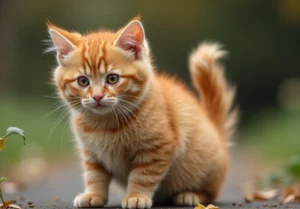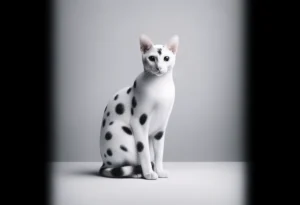Cats in Asia have a unique appearance that sets them apart from cats in other regions. Have you ever wondered why this is the case? Let’s explore the fascinating reasons behind why cats in Asia look different.
Evolutionary Adaptations
Cats in Asia have developed unique physical characteristics through evolutionary adaptations to their environment. From the rugged terrain of the Himalayas to the dense jungles of Southeast Asia, these felines have honed their traits to thrive in diverse landscapes. For example, the sleek and agile Japanese Bobtail is well-suited for hunting in tight spaces, while the Turkish Van boasts a water-resistant coat ideal for swimming in the lakes and rivers of Eastern Turkey.
One interesting insight into the evolutionary adaptations of Asian cats is their distinctive coat patterns. The Burmese cat, originally from Burma (now Myanmar), showcases a stunning sable coat color that helps it blend seamlessly with the rich earthy tones of its native habitat. This adaptation not only provides camouflage but also serves as a practical tool for survival in the wild.
Breeds and Lineages
Exploring the diverse array of cat breeds and lineages found in Asia unveils a fascinating tapestry of feline diversity. From the regal Siamese cat with its striking blue eyes to the enigmatic Korat known for its silver-blue coat, each breed offers a unique glimpse into the rich heritage of Asian felines. Additionally, the Sokoke cat, originating from Kenya but with roots in Asia, showcases a rare tabby coat pattern reminiscent of its ancestral ties.
One lesser-known lineage worth highlighting is the Singapura cat, which hails from Southeast Asia. This petite feline boasts a warm sepia coat color and large, expressive eyes, making it a beloved companion in households across the region. The Singapura cat‘s diminutive size and affectionate nature reflect its close bond with humans, a result of centuries of domestication and selective breeding.
Remember, each cat breed and lineage in Asia has a story to tell, a legacy of resilience and adaptation that makes them truly unique in the world of felines. Explore these diverse feline companions and marvel at the rich tapestry of cat heritage found across the vast continent of Asia.
Cultural Significance
In many Asian societies, cats hold a special place of honor and reverence. From ancient times to modern day, these feline friends have been symbols of luck, protection, and prosperity. In countries like Japan and Thailand, cats are considered to bring good fortune and are even worshipped in temples. This deep cultural significance has influenced the appearance and characteristics of cats in Asia over centuries. Artwork, literature, and folklore often depict cats in regal and mystical ways, shaping the perception of these animals. Therefore, it’s no surprise that Asian cats may have distinct features that reflect this cultural significance, such as certain coat patterns or unique physical traits inspired by traditional beliefs.
Climate and Environment
The diverse climate and terrain of Asia have played a significant role in shaping the appearance of cats in the region. From the snowy regions of Siberia to the tropical jungles of Indonesia, cats in Asia have adapted to a wide range of environments. In colder climates, cats may develop thicker fur and larger bodies to survive harsh winters, while in hotter regions, cats may have shorter coats and slimmer builds to cope with the heat. The rich biodiversity of Asia has also influenced the coloration and patterns seen in cats. Therefore, it’s not uncommon to see Asian cats with unique and diverse appearances that reflect the climatic diversity of the continent.
- Tip: Provide shade and water for outdoor cats in hot climates to help them stay cool and hydrated.
Remember, the appearance of cats in Asia is a fascinating blend of cultural significance and environmental adaptation, making each feline in the region truly unique.
Genetics and Color Patterns
Genetics play a significant role in determining the unique appearance of cats in Asia. Asian cat populations exhibit a wide range of color patterns and traits, influenced by their genetic makeup. For example, the Japanese Bobtail is known for its short tail and unique coat patterns, while the Burmese cat is recognized for its sleek, solid-colored fur. These distinct characteristics are a result of specific genes that have been passed down through generations.
Through selective breeding and natural selection, certain color patterns have become more prevalent in Asian cat breeds, creating the diverse looks we see today. For example, the Siamese cat is famous for its distinctive point coloration, a result of a recessive gene that affects the cat’s fur color. This genetic diversity is what gives Asian cats their unique appearance compared to their counterparts in other regions.
Wildlife Influence
Interactions with diverse wildlife in Asia have also played a significant role in shaping the appearance and behavior of cats in the region. The environment in Asia is home to a wide variety of wild species, which has influenced the evolution of Asian cats over time. For instance, the Russian Blue cat is believed to have ancestral ties to Asian cats, with its striking silver-blue coat possibly evolving from interactions with local wildlife.
Asian cats have adapted to their environment by developing camouflaging fur patterns and hunting instincts that help them survive in their natural habitat. This influence from wildlife has contributed to the distinctive looks of Asian cats, setting them apart from felines in other parts of the world.
Additional Insight:
- Asian Leopard Cats, native to regions like India and Southeast Asia, have inspired hybrid breeds such as the Bengal cat, known for its spotted coat and energetic personality. This unique blend of domesticity and wild heritage adds to the appeal of Asian cats and their exotic appearance.
Modern Influences
Cat breeds in Asia have evolved over time due to modern influences like cross-breeding and international influences. With globalization, cats have been bred with different breeds from all around the world, resulting in unique appearances that may differ from traditional Asian cat breeds. This cross-breeding has led to a diverse range of characteristics and colors in cats across Asia, making them stand out in terms of their appearance. Additionally, international influences such as the popularity of certain cat breeds in other parts of the world have also played a role in shaping the look of cats in Asia today. These modern factors have contributed to the distinctive appearance of Asian cats that we see today.
Trivia: Mythical Connections
Cats in Asia have a long history of being associated with mythology and folklore, adding to their mystique and allure. In Japanese folklore, the Maneki Neko, or “beckoning cat,” is believed to bring good luck to its owner. This iconic cat figurine is often seen in shops and businesses, welcoming customers with its raised paw. In Chinese folklore, the “Li Shou” is a mythical creature resembling a lion that is said to have a cat-like appearance. It is believed to bring prosperity and good fortune to those who encounter it. These mythical connections highlight the special place that cats hold in Asian cultures, further shaping their unique image and appearance.
Unique Insight: Some Asian cultures believe that certain cat colors or patterns bring specific types of luck. For example, in Japanese culture, calico cats are considered to bring good fortune, while in Chinese tradition, black cats are associated with warding off evil spirits. These beliefs have influenced the breeding and selection of cat colors in Asia, leading to a variety of unique coat patterns and colors in Asian cats.
Alex, a passionate animal lover, has experience in training and understanding animal behavior. As a proud pet parent to two dogs and three cats, he founded AnimalReport.net to share insights from animal experts and expand his knowledge of the animal kingdom.




